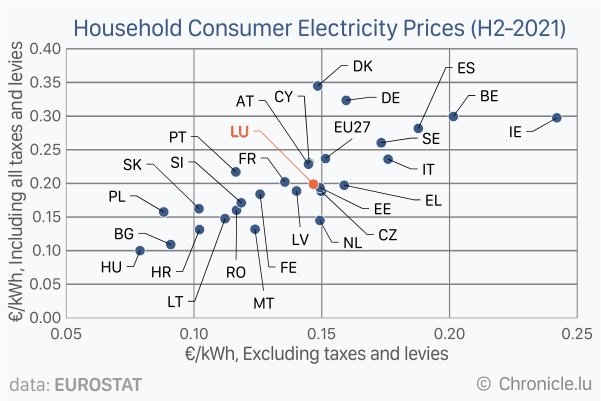
Electricity price for household consumers increased in the second half (H2) of 2021 compared to second half of 2020 in 25 out of 27 European Union (EU) Member States, according to data analysed from the European statistics agency Eurostat.
The bi-annual electricity prices (H1 = January to June, H2 = July to December) for household consumers of medium-size (annual consumption between 2,500 kWh and 5,000 kWh) vary largely across the EU, mainly due to different supply and demand conditions, national energy mixes (proportion of electricity generation sources), network costs and non-harmonious national excise and taxation levels.
Electricity prices for households, including all taxes and levies, were highest in Denmark in the H2-2021 at 0.3448 €/kWh (Euro per kilowatt-hour), closely followed by Germany (0.3234 €/kWh), Belgium (0.2994 €/kWh) and Ireland (0.2974 €/kWh). In comparison, Hungary had the lowest electricity prices at 0.1001 €/kWh, less than a third of that of Denmark and Germany, and less than half of that of EU average (0.2369 €/kWh), followed by Bulgaria (0.1091 €/kWh) and Croatia (0.1313 €/kWh).
Luxembourg households had to pay 0.1989 €/kWh in H2-2021, less than 1% increase compared to 0.1985 €/kWh in the H2-2020. The prices are compared year-on-year, i.e., H1(n) to H1(n-1) and H2(n) to H2(n-1), to avoid seasonal effects.
Acoss EU, Estonia recorded the highest increase in electricity prices in H2-2021 compared to H2-2020 at 50.2%, followed by Sweden (49.3%) and Cyprus (35.7%), whilst Slovakia and Hungary reported a net decrease in prices, down 5.8% and down 0.13%, respectively, the only two EU Member States to record net decrease in prices. However, it should be noted that electricity prices in Slovakia and Hungary are regulated.
Electricity prices without taxes and levies, that is the cumulative of energy generation costs, supply costs and network costs, remained largely stable throughout 2014 to 2019. On average, taxes and levies accounted for 36% of final electricity costs for households in the EU. The taxes were highest in Denmark, accounting 56.9% of the net price, while in contrast, the taxes were negative in the Netherlands (down 3%) due to an allowance given to consumers, wherein the tax burden is transferred from households to non-households consumers.
The graph shows the electricity prices with and without taxes across the 27 EU Member States in S2-2021.
Network costs, a key component of the final electricity price, also vary considerably among the Member States. Made up of transmission costs (transmitting large amounts of electricity over long distances) and distribution costs (consumers connections to the distribution grid), regions of high population density generally has high distribution costs compared to far and low populated areas, which have a higher share of transmission cost. Luxembourg, the only Member State with 100% distribution cost, is closely followed by Slovakia (91.3%) and Finland (90.0%), whilst Estonia (63%) and Poland (69.6%) had the lowest share of distribution costs (but higher share of transmission costs).
Luxembourg also had the highest share of electricity import dependency, at 88.15% of total electricity available for final consumption on its territory in 2021.








